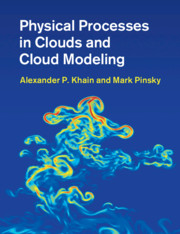Book contents
- Physical Processes in Clouds and Cloud Modeling
- Physical Processes in Clouds and Cloud Modeling
- Copyright page
- Contents
- Preface
- Abbreviations
- Symbols
- 1 Clouds: Definitions and Significance
- 2 Cloud Particles and Their Representation in Cloud Models
- 3 Basic Equations
- 4 Numerical Methods Used in Cloud Models
- 5 Warm Microphysical Processes
- 6 Microphysical Processes in Ice and Mixed-Phase Clouds
- 7 Modeling: A Powerful Tool for Cloud Investigation
- Book part
- Index
- References
5 - Warm Microphysical Processes
Published online by Cambridge University Press: 22 August 2018
- Physical Processes in Clouds and Cloud Modeling
- Physical Processes in Clouds and Cloud Modeling
- Copyright page
- Contents
- Preface
- Abbreviations
- Symbols
- 1 Clouds: Definitions and Significance
- 2 Cloud Particles and Their Representation in Cloud Models
- 3 Basic Equations
- 4 Numerical Methods Used in Cloud Models
- 5 Warm Microphysical Processes
- 6 Microphysical Processes in Ice and Mixed-Phase Clouds
- 7 Modeling: A Powerful Tool for Cloud Investigation
- Book part
- Index
- References
Summary
Microphysical processes that are not related to ice formation are often referred to as warm microphysical processes. It does not mean that these processes take place at positive temperatures only. Drops of a particular kind (supercooled drops) can exist at temperatures as cold as −38°C; nevertheless their diffusional growth and collisions are considered as warm microphysical processes. The major warm microphysical processes and terms of kinetic equations describing their rates are listed in Table 5.1.1.
Information
- Type
- Chapter
- Information
- Physical Processes in Clouds and Cloud Modeling , pp. 151 - 343Publisher: Cambridge University PressPrint publication year: 2018
